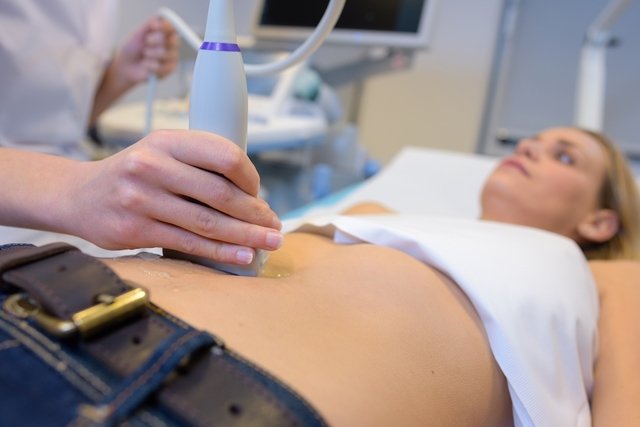Appendicitis is inflammation of the appendix, a small portion of the large intestine that is located in the lower right part of the abdomen. The most typical sign of appendicitis is pain in the lower part of the belly on the right side, which may be accompanied by lack of appetite, nausea, vomiting and fever.
Typically, appendicitis occurs due to obstruction of the appendix by remains of hardened feces. However, the obstruction can also be caused by worms and, in rarer cases, by intestinal tumors.
To treat this problem, the appendix must be removed as quickly as possible through surgery recommended by the doctor, to avoid complications such as rupture of the appendix, which can lead to a generalized infection. Therefore, if appendicitis is suspected, it is important to go to the hospital immediately to undergo tests and confirm the diagnosis.
Main symptoms
The main symptoms of appendicitis are:
- Pain and increased sensitivity in the abdomen;
- Nausea and vomiting;
- Loss of appetite;
- Fever;
- Feeling of uneasiness;
- Diarrhea;
- Frequent urge to urinate, in some cases.
Symptoms of acute appendicitis typically appear within 24 hours and pain is one of the most common initial symptoms of appendicitis. In the first few hours after it starts, the pain tends to be located around the navel, but can affect the entire belly in some cases.
Read too: 9 main symptoms of appendicitis (with online test)
However, after about 12 to 48 hours it is common for the pain to shift to the lower part and right side of the abdomen, where it is more characteristic. Furthermore, the pain of appendicitis usually worsens when pressing the stomach, coughing and, sometimes, walking, for example. Understand better what appendicitis pain is like.
Don’t ignore your symptoms!
If you think you may have appendicitis, select your symptoms from the list below and find out the chances:
This test is only a tool for guidance and therefore does not replace consultation with a surgeon or general practitioner.
How to confirm the diagnosis
The diagnosis of appendicitis is usually made by a surgeon or general practitioner through a physical examination and taking into account the symptoms present. However, it is common for the doctor to recommend tests, such as ultrasound or tomography, to confirm the diagnosis.
One way to try to find out if it could be appendicitis is to lie on your back and press with one hand on the lower part of your belly on the right side. Afterwards, the pressure must be quickly relieved and, if the pain is more intense, it may be an indication of appendicitis.
Read too: How to know if it is appendicitis
If appendicitis is suspected, it is recommended to seek emergency care to confirm the diagnosis and initiate appropriate treatment.
Tests to identify appendicitis
The main tests recommended for appendicitis are:
- Blood count: allows you to assess the amount of white cells in the blood, which helps confirm the presence of inflammation in the body;
- PCR dosage: is a blood test that may be altered in the case of inflammation and infections;
- Abdominal ultrasound: allows you to identify the inflamed appendix;
- Computed tomography: allows you to observe in more detail the dilation and inflammation of the appendix.
In addition, sometimes the doctor may also recommend other tests, such as a urine test, especially when the symptoms present are not characteristic of appendicitis.
Possible causes of appendicitis
In most cases, appendicitis is caused by an obstruction in the appendix, a small portion of the large intestine, due to hardened stool remains. When this happens, bacteria in the appendix can multiply, causing inflammation.
Furthermore, it is believed that obstruction of the appendix can also occur due to worms and, sometimes, more serious problems such as intestinal tumors, for example. Learn about other causes of appendicitis.
How the treatment is carried out
Treatment for appendicitis is typically done with:
1. Surgery for appendicitis
Surgery to remove the appendix, known as appendectomy, is the main form of treatment for acute appendicitis. This surgery is commonly performed laparoscopically, a technique that is less invasive and favors postoperative recovery.
Read too: Appendicitis surgery: how it is done, risks and recovery
2. Medications
Medications, such as antibiotics and analgesics, are usually indicated to complement the treatment of appendicitis through surgery to remove the inflamed appendix.
3. Diet for appendicitis
Dietary changes are important after surgery to remove the appendix to promote bowel function and post-operative recovery.
Especially in the first few days after leaving the hospital, a light, easily digestible diet consisting mainly of clear liquids is recommended. Find out what your diet should be like after appendicitis.
Possible complications
The main complications of appendicitis are:
- Appendix perforation: Also called suppurative appendicitis, it occurs when the appendix ruptures, releasing bacteria into the abdomen. Some symptoms that may indicate perforation of the appendix include general malaise, increased fever, belly swelling and a feeling of shortness of breath;
- Abdominal abscess: occurs due to the worsening of the infection, causing the accumulation of pus around the inflamed appendix;
- Fistula formation: Sometimes appendicitis can cause the emergence of a fistula, which is a small channel, connecting the inflamed appendix to the skin, especially when there is an abscess.
Complications of appendicitis are more common when treatment takes a long time and can put the person’s life at risk. Therefore, if appendicitis is suspected, it is important to go to the emergency room as soon as possible for an evaluation.
In how many days does appendicitis develop?
Appendicitis can take more than 2 days to develop complications, such as appendix perforation and abscess formation. However, the risk tends to be greater with each passing day when appendicitis is left untreated.
Although it is rare, there are milder cases in which inflammation of the appendix may become persistent or recurrent, known as chronic appendicitis. In these cases, its evolution may be even slower. Understand better what chronic appendicitis is.
Is having appendicitis during pregnancy dangerous?
It is dangerous to have appendicitis during pregnancy because the appendix can rupture, spreading bacteria inside the abdomen and causing serious infections for mother and baby.
Appendicitis during pregnancy has the same symptoms and surgery is usually also indicated for treatment, without being harmful to the baby’s development.
Read too: How to identify and treat appendicitis in pregnancy
Therefore, it is important that pregnant women, when experiencing intense and continuous pain on the right side of the abdomen, seek hospital to confirm the diagnosis and begin appropriate treatment.

Sign up for our newsletter and stay up to date with exclusive news
that can transform your routine!
Warning: Undefined array key "title" in /home/storelat/public_html/wp-content/plugins/link-whisper-premium/templates/frontend/related-posts.php on line 12
Warning: Undefined array key "title_tag" in /home/storelat/public_html/wp-content/plugins/link-whisper-premium/templates/frontend/related-posts.php on line 13




